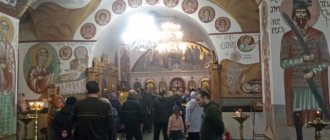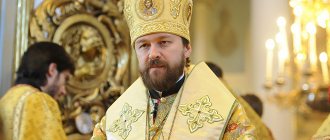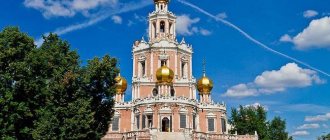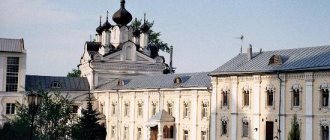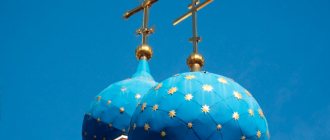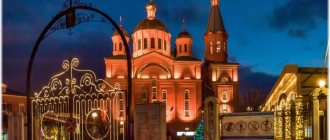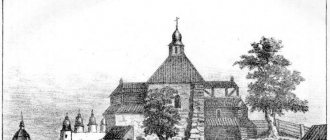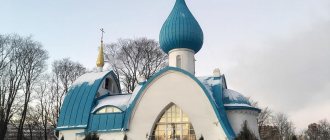| Moscow, Church of St. George the Victorious in Gruziny |
Moscow Church in honor of the Great Martyr George the Victorious in Gruziny
- Throne: martyr. St. George the Victorious
- Address: Russia, Moscow, st. B. Gruzinskaya, 13
- Website:
- Tel.: 254-09-85
- Directions: M. "Barrikadnaya", troll. 66. You can also get there from the Krasnopresnenskaya metro station - as well as from Barrikadnaya - about a 10-minute walk along the fence of the zoo.
- On the map: Yandex.Map, Google map
The Church of the Great Martyr George was located in the very center of the Georgian settlement in Moscow, near the palace of King Vakhtang VI (now the German Embassy is located in its place), at the intersection of St. George Square and the Kabanikha River (now Zoological Lane).
It was built on the site of the Church of St. John the Evangelist, opened by order of Alexei Mikhailovich and burned down in the middle of the 18th century. The son of Vakhtang VI, Tsarevich George, approached Moscow Archbishop Platon with a request for permission to build it. In November 1749 permission was given. The wooden church was obviously built at the expense of Tsarevich George. It was consecrated by Archbishop Joseph Samebeli (I.T. Kobulashvili).
Divine services in the church were conducted in Georgian. In 1779, St. George's Church burned down, but the sacristy was saved.
On the site of the wooden church, construction began on a stone church, which was consecrated in 1800. Throughout the 19th century. Church of St. Georgia expanded and settled down.
In 1807, the Tsitsianov princes (Tsitsishvili) built mahogany chapels in the name of Peter and Paul. They donated the most valuable relics to the church - an altar cross, a Gospel, liturgical books, vessels, an ark, etc. The younger brother of a famous political figure of the early 19th century. Pavel Dmitrievich Tsitsianov - Mikhail - was a church ktitor for 25 years.
In 1841, an iconostasis was installed in the church, and in 1870, the height of the bell tower was increased. In 1897, a new building was built in the pseudo-Byzantine style (architect Sretensky) to the old church, which could no longer accommodate all the parishioners (due to the growing population in this area of Moscow).
The church was considered rich; it housed Orthodox Georgian relics (including the cross of St. Equal-to-the-Apostles Nina, the enlightener of Georgia), as well as a rich library, which contained old printed books in Old Church Slavonic and Georgian.
At the church in 1864 M.D. Tsitsianov established an almshouse for elderly nuns.
Until the end of the 1920s. Services were held in the church. In 1930, the church was closed and the building was rebuilt: the bell tower and dome were dismantled, and interfloor ceilings were built. The library was probably taken away. Since that time, the church has housed the evening electromechanical technical school named after. Krasina.
According to the Orthodox Moscow directory, the temple was closed in 1929; in 1993, the ancient part of the temple was returned to the Church, the new part is still occupied by the technical school.
The temple has a very unusual new painting in the Byzantine style.
According to the agreement between the Russian Orthodox and Georgian Orthodox Churches, a clergyman of the Georgian Church also serves in this church, which belongs to the Moscow Patriarchate, and services are conducted in Church Slavonic and Georgian [1].
Moscow Church of St. St. George the Victorious on Krasnaya Gorka
Church of St. St. George the Victorious on Krasnaya Gorka. Photo from the book by N.A. Naydenova
This year marks 1701 years since the death of St. Great Martyr George the Victorious - one of the most revered saints in Rus', revered as the patron saint of Moscow. In the Mother See, many churches were built in his honor, long before the image of the saint appeared on the Moscow coat of arms - some survived dark times and survived to this day, others died during the years of Soviet power.
Saint George was born in the Lebanese city of Beirut (Berit) on the Eastern Mediterranean coast at the end of the 3rd century AD. in an aristocratic, rich and pious family - the parents raised their son in the Christian faith. The young man entered military service under the Emperor Diocletian, a zealot of Roman paganism and a fierce opponent of Christianity: it was under him that the most severe persecution of the confessors of Christ began. Emperor Diocletian noticed a young, strong and brave warrior, and Saint George, enlisted in the imperial guard, became his favorite.
And soon St. George became an eyewitness to the unjust trial of Christians, which sentenced them to death for their true faith. Then the warrior, realizing that this fate awaited him as a Christian, completed his earthly affairs - he freed his slaves and distributed property to the poor - and he himself appeared before Emperor Diocletian. Before the formidable tyrant St. George openly professed the Christian faith and exposed its atrocities, speaking out against the imperial order to persecute Christians.
Diocletian ordered the warrior to be imprisoned and tortured most cruelly, and, unable to get him to renounce Christ, he sentenced him to death by beheading with a sword. Saint George was executed in Nicomedia in 303 - he did not live to be 30 years old. His holy relics were laid to rest in Palestine, in the city of Liddi, in a temple dedicated to him, and his head was placed in the same temple in Rome itself.
And after the death of the great martyr, the famous Miracle of St. took place. George about the serpent, which not only strengthened the glorification of the saint, but also determined the subsequent iconography of his image, and then the Moscow Coat of Arms itself - the saint is depicted on a white horse with a spear in his hands, slaying the serpent.
According to legend, in the homeland of St. George, in a lake near the city of Beirut, some kind of giant snake really appeared - perhaps a crocodile or a boa constrictor. He posed a huge danger to the local residents, as they began to constantly bring him human sacrifices by lot, a boy or a girl, in order to “appease” the monster and satisfy his hunger, as in ancient pagan times. And one day the lot fell on the daughter of the ruler himself - the danger was such that even her father could not do anything for her. The girl was taken to the shore of the lake and tied to a tree. And when the monster climbed out of the water, suddenly a “bright young man” appeared on a white horse and killed the reptile with a blow of a spear. So he not only saved the girl and local residents from harm and stopped terrible pagan sacrifices, but also converted the entire surrounding population to the Christian faith.
Saint George is considered the patron of the army, livestock and protector from predators. On his spring holiday in Rus', cattle were driven out into the field for the first time after wintering. But the autumn, November holiday of the saint entered the history of Russia as the famous “St. George’s Day”, celebrated on November 26 according to the old style. In medieval times, it was the last bastion of freedom for the Russian peasantry - it was on this day, once a year, that they were allowed to move from one landowner to another, when at the end of November a strong sleigh track was installed, which made it possible to move. And only under Ivan the Terrible, in 1581, this transition rule was abolished, which finally established the most brutal serfdom until 1861. Then the famous saying appeared: “Here’s St. George’s Day for you, grandma.”
In old, pre-revolutionary Moscow there were several churches consecrated in the name of St. George. Some of them have survived to this day - on Pskov Hill in Kitai-Gorod on Varvarka, in Zamoskvorechye, in Luchniki on Lubyanka. The Lubyanka Church opened in such a disfigured state that in the mid-1990s, when this temple was returned to believers, it was not believed that these ruins could be restored at all. And then, after the fall of the USSR, the St. George Church was built on Poklonnaya Hill, revealing a new direction in church architecture.
In the center of old Moscow there was a whole monastery dedicated to St. George - in the lane of the same name between Tverskaya and Bolshaya Dmitrovka, now only the beautiful wall of this monastery remains, and on the site of the monastery demolished by the Bolsheviks, a standard school building was built. There are also many destroyed parish churches of St. George - on Vspolye in the area of Bronnaya and Spiridonovka, in Khamovniki and on Krasnaya Gorka on Mokhovaya. This last church, which stood next to the main building of Moscow State University on Mokhovaya, was connected with the fate of Moscow University.
The church stood next to the National Hotel, on the site where Stalin’s house No. 6 now stands. The name of the area - Mokhovaya - came, according to one version of historians, from the shops that stood here, which sold dry moss for caulking wooden Moscow houses. Or there was simply a swamp here, abundantly overgrown with moss.
St. George's Church on Mokhovaya was founded, according to legend, by the nun Martha herself, the mother of the first tsar from the Romanov dynasty, Mikhail Fedorovich. However, in historical literature there is news that the church was mentioned in the spiritual charter of Grand Duke Vasily the Dark, and in 1462 it was listed as a stone church. It is possible that the ancient church burned to the ground, and the nun Martha built a new, wooden one in its place. And indeed, we find confirmation of this version in the chronicle when describing the fire in Moscow in 1493: the fire from Arbat spread to “Neglina to the stone church of St. Yegoriy.” But already in 1629 there is a mention that the Church of St. George the Passion-Bearer on Gorka Drevyana burned down - which means that at that time it really was already wooden. It is possible that it was the nun Martha who founded it or restored it as a wooden one in place of a stone one.
The temple was built on a hill, where, in all likelihood, in ancient times, folk festivals on Krasnaya Gorka were celebrated in the spring - hence the name of this area on the banks of the Neglinka. The celebration was fun - with round dances, games, and festivities. According to popular belief, it was believed that those who got married on Krasnaya Gorka would be happy all their lives. And since this holiday was in spring, on the first Sunday after Easter, according to tradition it was celebrated where there was a lot of warmth and sun.
The wooden church burned down in the 20s of the 17th century, and the parishioners built a stone church on their own in the same place - in 1652-1657. Then the temple was decorated and landscaped by local eminent and wealthy homeowners who lived in this privileged area of old Moscow: thus, on the second floor of the St. George’s Church, the Baryatinsky princes consecrated a chapel in the name of St. Archangel Michael. In 1817, it was here that the temporary house church of Moscow University opened, and then this chapel was reconsecrated in the name of St. Martyr Tatiana. Moscow University had to move under the shadow of St. George, since its own church in the left wing of the main building on Mokhovaya burned down in a fire in 1812.
And it was here, in the newly consecrated Tatianinsky chapel of the St. George Church, that students of Moscow University swore allegiance to Grand Duke Konstantin Pavlovich, and then to his brother Nicholas I in December 1825.
And here, on Tatiana’s Day in 1831, a solemn service was held after the terrible cholera epidemic in Moscow - when the disease had already subsided in the city. First, the Right Reverend Dionysius served the Liturgy in the church, and then the students raised local icons and the image of St. Martyrs Tatiana and transferred them to a large university auditorium, where a thanksgiving prayer service was performed and many years were proclaimed to the Sovereign Emperor Nikolai Pavlovich and the August House. Then the students' rooms, dining room and lecture halls were sprinkled with holy water.
However, services in the ordinary parish St. George's Church turned out to be inconvenient for the majority of university parishioners - a steep staircase with large steps led up, and not all elderly people could overcome it, especially in bad weather, and it was almost impossible to perform a funeral service there. In addition, the second floor was not heated, and it was impossible to hold services during the cold season - which was the main university and patronal January holiday, Tatiana's Day.
In addition, the chapel room on the second floor was very small for holding crowded university celebrations - the priest of the St. George Church, Zakhary Yakovlev, who began to act as the university priest, served on major holidays and during Lent right in the main building of Moscow University.
Only in 1832, Emperor Nicholas I bought for the university the neighboring Pashkov estate on Mokhovaya, located between Vozdvizhenka and Bolshaya Nikitskaya, and possibly built by Vasily Bazhenov himself. (Now this is the Auditorium Building of Moscow State University). And in its left wing in 1837 a new house church of Moscow University was opened, which still operates there today. (for more details, see our publication dated January 25 this year)
From that time on, St. George's Church again became an ordinary parish church. Only in the early Soviet years did history again connect it with the fate of Moscow University, when its house church was closed by the Bolsheviks almost immediately after the revolution. In January 1920, they secretly served in the St. George Church on Tatiana's Day, celebrating the 165th anniversary of Moscow University. And the first university services after the closure of his own church were again held in the St. George Church on Mokhovaya.
However, the revolution doomed this temple to destruction. In April 1932, the Moscow Soviet asked the All-Russian Central Executive Committee for permission to demolish the St. George Church and in its place build an elite residential building in a new architectural style. Permission was received, and in 1934 the famous architect I.V. Zholtovsky built a multi-storey building on Mokhovaya, which became the very first example of “Stalinist Empire” architecture in Moscow, which was quietly replacing revolutionary constructivism. And although this new style was so called in the apt and sharp Moscow vernacular, indeed, for the decorative design of the building, Zholtovsky again used elements of classical order architecture, which the constructivist theorist Le Corbusier himself had abandoned. Sometimes they even wrote that Zholtovsky’s work was built in the Italian “Palladio” style, but more often it was called Stalin’s Empire style and was bitterly ironic - “Empire during the plague.”
This expression was not accidental - the house was clearly built for the high-ranking party and state elite. The famous Moscow historian Sergei Romanyuk provides data on polished parts, stucco on the ceiling, parquet flooring without a single knot, polished doors and a room (alcove) for a housekeeper in each apartment of this “stone-hewn monument to party politics.”
But it so happened that in our time, once again, the fate of Moscow University and its house church turned out to be invisibly connected with the memory of the ancient St. George Church and the most holy patron of Moscow. It was on the day of the feast of St. George, May 6, 1995, that a large wooden cross was again erected on top of the Tatianinsky Church of Moscow State University on Mokhovaya for the first time since the October Revolution. It is now clearly visible from Manezhnaya Square.
The last rector of the Church of St. George, Vladimir Proferansov, was ranked among the new martyrs
In August 2000, the anniversary congress of the Bishops' Council of the Russian Orthodox Church took place. One of the topics was the acceptance of the new martyrs and confessors of Russia. Among others, the last rector of the church, St. George, Archpriest Vladimir Proferansov.
Father held the important post of secretary of Patriarch Tikhon. When people from the NKVD came to him and offered cooperation. The archpriest refused. He was arrested, then convicted and sent into untimely exile.
December 15
official day of remembrance of the new martyr Vladimir Lubyansky
In 1937, Vladimir’s father was sent by convoy to the Butovo training ground, where OBKOM troikas were working at that moment. From one of these groups, an archpriest was sentenced to death.
December 15 became the official day of memory of Vladimir Lubyansky. Moreover, commemoration of the saint began in the same year 2000. The icon of the holy martyr was painted for this date. However, it was only in 2007 that a full-fledged celebration was held in honor of St. Vladimir Lubyansky for the first time.
By leaving a comment, you accept the user agreement

